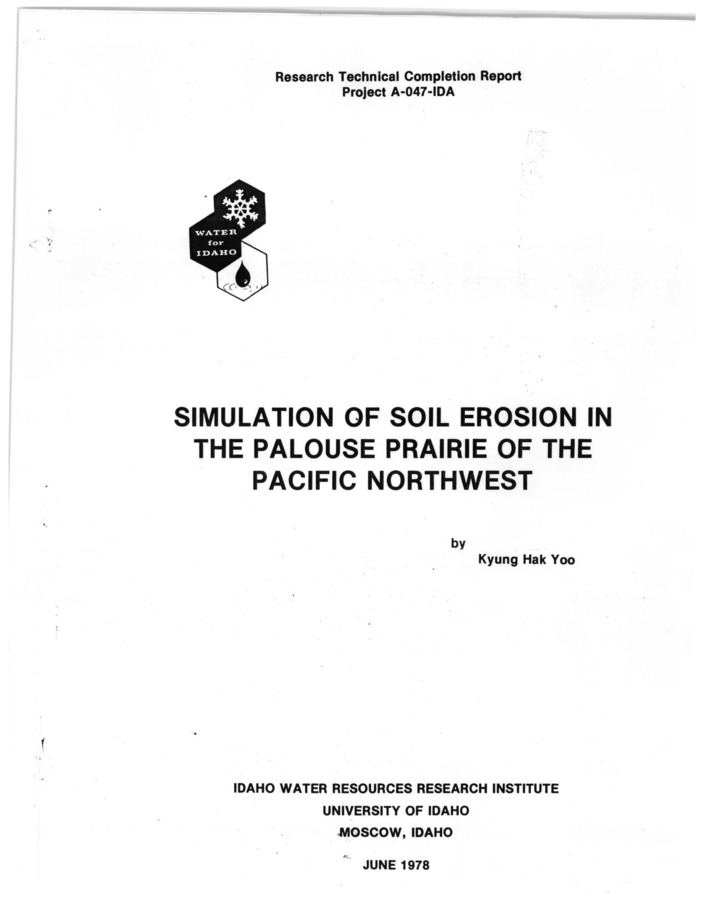PDF
Simulation of soil erosion in the Palouse. Research technical completion report, project A-047-IDA Item Info
- Title:
- Simulation of soil erosion in the Palouse. Research technical completion report, project A-047-IDA
- Authors:
- Yoo, Kyung Hak
- Contributors:
- Idaho Water Resources Research Institute; IWRRI
- Date:
- 1978-06
- Description:
- A soil erosion simulation study was done to help understand the severe soil loss from agricultural lands in the Palouse Prairie of the Pacific Northwest. A soil erosion model was coupled with the Idaho version of the USDAHL watershed model which supplied primary information such as rainfall, snowfall, snowmelt, overland flow, stream flow, soil moisture and crop growth index to the erosion model. The main factors used by the erosion model are: overland flow, rainfall, snowmelt, snow covered area, organic material covered area, soil moisture, rill development on upland areas and stream flow for channel scouring. These are used to calculate soil particle detachment and transport capacity of raindrop and overland flow. There are several coefficients which are used to estimate the conditions for or against soil erosion. This first generation Palouse erosion model was fitted to measured sediment discharge by using trial-and-error techniques. The model was tested on two different size watersheds (3.3 hectare and 59.4 hectare) near Moscow, Idaho. The results showed poor simulation on a daily basis. The monthly and yearly simulations were good compared with the observed except for the period of high stream flow simulated at the start of the water year. The eroded particles from each hydrologic zone cascades to a lower zone and finally to the channel. This cascading system shows the amount and location in terms of zones, where the erosion and deposition occur. Rill depth and distribution for any erosion period are the most important part of the model since rill erosion is calculated as a function of them. From field measurements rill erosion has proven to be one of the most serious erosion sources in the Palouse. Channel scouring erosion is not as significant as upland erosion. High stream flow does not necessarily cause high soil loss and vice versa. Many of the problems, particularly with upland erosion, can be traced to inadequacies in the hydrologic model. This is the first study of its type in the Palouse area. There must be further calibration and modification of both the hydrologic and erosion model in order to improve the simulation of erosion in this area.
- Subjects:
- hydrologic models rill erosion erosion control watershed models
- Location:
- Palouse Region
- Idaho County:
- Latah County
- Latitude:
- 46.74
- Longitude:
- -117.24
- Collection:
- IWRRI
- Series:
- Water for Idaho
- Source:
- Idaho Water Resources Research Institute, University of Idaho
- Identifier:
- IWRRI Number 197815
- Publisher:
- Idaho Water Resources Research Institute, University of Idaho
- Contributing Institution:
- University of Idaho
- Type:
- Text
- Format:
- application/pdf
- Cataloger:
- wbv
- Date Digitized:
- 2012
- Language:
- eng
Source
- Preferred Citation:
- "Simulation of soil erosion in the Palouse. Research technical completion report, project A-047-IDA", Idaho Waters Digital Library, University of Idaho Library Digital Collections, https://www.lib.uidaho.edu/digital/iwdl/items/iwdl-197815.html
Rights
- Rights:
- In copyright, educational use permitted. Educational use includes non-commercial reproduction of text and images in materials for teaching and research purposes. For other contexts beyond fair use, including digital reproduction, please contact the University of Idaho Library Special Collections and Archives Department at libspec@uidaho.edu. The University of Idaho Library is not liable for any violations of the law by users.
- Standardized Rights:
- http://rightsstatements.org/vocab/InC-EDU/1.0/

